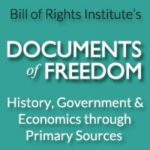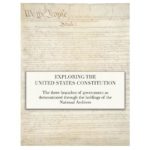Discover the documents at the bedrock of our nation’s founding and understand the fundamental ideas from each of the documents, and the major principles of the U.S. Constitution. Primary sources include the Declaration of Independence, Articles of the Confederation, the Constitution and the Bill of Rights, Federalist papers (#51, #70, #78), Brutus #1, and the amazing Letter from the Birmingham City Jail. Check out the National Constitution Center’s learning module for more resources!
Landmark Lessons
Find lesson plans generated by teachers who completed the Cultures of Independence workshop at the Historical Society of Pennsylvania. The lessons illustrate how local and national history can be taught through a focus on a physical place and primary sources. Criteria for selecting lessons also included the teaching of historiography and, when appropriate, connections to the founding principles of the United States. Use a lesson from your region, or become inspired to create your own.
The Influence of the Declaration of Independence on the Constitution
In this lesson, students will use C-SPAN video clips to examine the founding principles that emerged from the Constitutional Convention as well as hear about some of the people who participated. Students will use this information to analyze the role the compromise played in the creation of the Constitution.
The Constitutional Convention
In this lesson, students will use C-SPAN video clips to examine the founding principles that emerged from the Constitutional Convention as well as hear about some of the people who participated. Students will use this information to analyze the role the compromise played in the creation of the Constitution.
Founding Documents: Magna Carta Podcast
Magna Carta was sealed on a field in England in 1215. Its purpose was to appease some frustrated barons, and it was never intended to last. Over 800 years later, this document is credited with establishing one of the most foundational principles of our democracy. So what does Magna Carta actually say? And how did it get from dubious stalling tactic in the 13th century to Supreme Court arguments in the modern era?
In this episode, you’ll learn how Magna Carta survived and thrived its way into our democracy.
This short episode includes a one-page Graphic Organizer for students to take notes on while listening, as well as discussion questions on the back side.
Choosing to Make a Nation: Constitutional Convention Simulation
The Choosing to Make a Nation Curriculum Project developed by award-winning author Ray Raphael is a student-centered, primary source-rich approach to teaching about American history and our nation‘s founding documents.
An 8-lesson simulation in which students become delegates from specific states and address the same issues the framers faced. Unit includes the following lesson plans –
(1) Reform or Revolution?
(2) Composition of Congress
(3) Creating an Executive Branch
(4) Should Judges Judge Laws?
(5) Balance of Powers
(6) Slavery and the Constitution
(7) Amendments and Ratification
(8) To Sign or Not to Sign?
Option A: The historical Constitution
Option B: Student-generated constitution
Court Shorts: Separation of Powers
In a five-minute video, federal judges offer insights into their thinking about the separation of powers and describe how healthy tensions among the branches have a stabilizing effect on democracy. The judges also share their respect for and commitment to this founding principle, which has an impact on everyday American life.
Documents of Freedom: History, Government, and Economics Through Primary Sources

This complete online textbook covers American history, government, and economic concepts. Resources include readings for students, activity directions for teachers, and handouts that are downloadable and printable for classroom use. Content is geared toward students in grades 8-12. All materials are aligned with Common Core and individual state standards.
Exploring the United States Constitution eBook

Each chapter connects one or more of the billions of primary source documents in the holdings of the National Archives to the principles found in the United States Constitution. These documents exemplify the workings of the three branches of the federal government as laid out in our Constitution. This eBook is available as a Multi-Touch book for iPad and Mac on iTunes, or for PC, Android devices, Mac, iPhone, iPad, or eReader with Scribd.